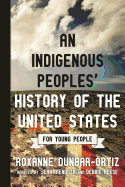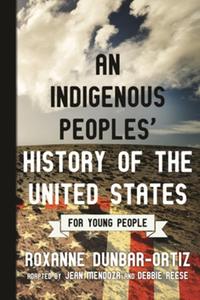
 Curriculum specialists Debbie Reese and Jean Mendoza have adapted Indigenous human rights activist Roxanne Dunbar-Ortiz's acclaimed academic text An Indigenous People's History of the United States for young readers. This history of North America's native tribal nations rebuts popular cultural beliefs and offers school-aged children a different perspective on the colonization of what is currently known as the United States.
Curriculum specialists Debbie Reese and Jean Mendoza have adapted Indigenous human rights activist Roxanne Dunbar-Ortiz's acclaimed academic text An Indigenous People's History of the United States for young readers. This history of North America's native tribal nations rebuts popular cultural beliefs and offers school-aged children a different perspective on the colonization of what is currently known as the United States.
An Indigenous Peoples' History of the United States for Young People spans centuries of resistance by the more than 500 federally recognized nations in the U.S. Even though the authors cover vast numbers of people and a long period of time, this account of the country's evolution remains gripping, tightly written and packed with facts traditional textbooks and historical accounts neglect to cover.
In place of the standard "hero tales" of explorers, soldiers, politicians and others is a well-researched, frank, often heartbreaking narrative of industrious, developed civilizations decimated by greed and ambition, justified by so-called "divine decree." Dunbar-Ortiz explains that contrary to popular belief, the Native people of the continent lived in communities, built roads, developed systems of government and benefited from complex interrelationships. But, she also says, "from the first moment Europeans stepped onto what came to be known as North America, they left bloody footprints wherever they went seeking land and resources. They found, however, that Indigenous people were not easily scared off or conquered." Dunbar-Ortiz's account illustrates Europeans' attempts at deception, displacement, genocide and other atrocities, as well as the Indigenous people's efforts to withstand them and preserve their ways of life.
In addition to Dunbar-Ortiz's exceptional history, Reese and Mendoza provide innovative opportunities for important reflection on the material. Sidebars encourage readers to analyze the ideas, apply them to their own lives and empathize with the people they are learning about. They open up opportunities for discussion, such as responding to the question "Can you think of a time when you have heard people speak of a group or person in ways that dehumanize them, ways that make them a threatening 'Other'?" There are also clever suggestions for activities that apply the content to young readers' experiences, such as asking them to revise the musical Hamilton to include Indigenous characters. Maps, illustrations and photographs offer more ways to interact with the text, and a list at the conclusion suggests further readings.
While the Indigenous peoples of the North American continent suffered mightily at the hands of Europeans, Dunbar-Ortiz's bold work illustrates that their resilience and determination prevented the interlopers from the ultimate goal of extermination: "It is breathtaking, but no miracle, that they have survived as peoples." Thanks to Dunbar-Ortiz, Mendoza and Reese's work, old and young readers alike now have the benefit of a more complete understanding of part of the dark history of the United States. --Jen Forbus, freelancer
Shelf Talker: Curriculum specialists adapt an Indigenous human rights activist's work to reveal to young readers the history of the United States from the perspective of its original, Indigenous inhabitants.

